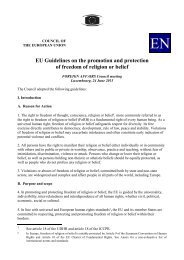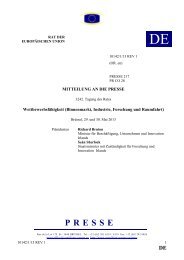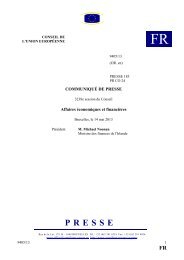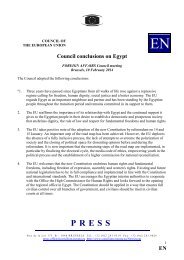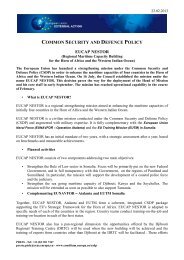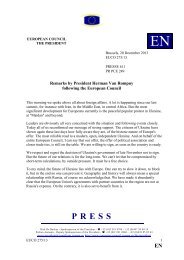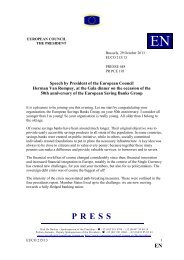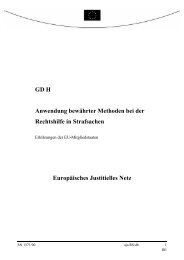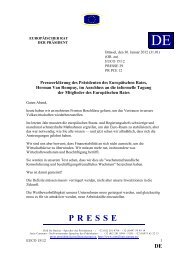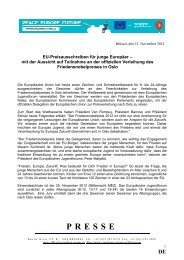14508/09 ADD 1 PL/vk 1 DG G COUNCIL OF THE ... - Europa
14508/09 ADD 1 PL/vk 1 DG G COUNCIL OF THE ... - Europa
14508/09 ADD 1 PL/vk 1 DG G COUNCIL OF THE ... - Europa
Create successful ePaper yourself
Turn your PDF publications into a flip-book with our unique Google optimized e-Paper software.
Indicator 2: Adequate resources are a basic element for progress in gender equality. A government<br />
commitment to promoting gender equality can therefore be measured in terms of resource allocation<br />
to the governmental gender equality body.<br />
Indicator 3: Mainstreaming gender equality is presented as the second main objective of the PfA<br />
critical area of institutional mechanisms. According to the PfA, governments should seek to ensure<br />
that before policy decisions are taken, an analysis of their impact on women and men respectively is<br />
carried out. Governments should also evaluate the impact of employment and income policies to<br />
ensure that women are direct beneficiaries of development. Governments should promote a gender<br />
perspective in legislation and give all ministries the mandate to review policies and programmes<br />
from a gender perspective. Inter-ministerial coordination structures should be established. In<br />
addition to the objectives addressed to governments, the PfA includes objectives addressed to<br />
national machineries, advising them on promoting gender mainstreaming. These objectives,<br />
however, deal more or less with the same issues as the ones directed at governments.<br />
The indicator on gender mainstreaming is regarded as a sum variable of key elements of gender<br />
mainstreaming. Important sub-indicators are the status of the governmental commitment to gender<br />
mainstreaming in public administration, i.e. whether it is a legal obligation, a de facto binding<br />
decision, recommendation etc, the existence of various types of structures and methods, such as<br />
inter-ministerial working groups on gender mainstreaming and the use of specific methods, namely<br />
gender impact assessment in drafting legislation and policy programmes, and gender budgeting.<br />
3.3 Progress of institutional mechanisms in the Member States<br />
3.3.1. Status of governmental responsibility in promoting gender equality 20<br />
All Member States have a governmental gender equality body (sometimes called equal<br />
opportunities body or women’s bureau) and this body often has an overarching responsibility, i.e.<br />
deals with several or all parts of the policy processes. In federal states there are several ministers<br />
20 Information from the MS reports to UNECE 20<strong>09</strong><br />
<strong>14508</strong>/<strong>09</strong> <strong>ADD</strong> 1 <strong>PL</strong>/<strong>vk</strong> 37<br />
ANNEX <strong>DG</strong> G EN



